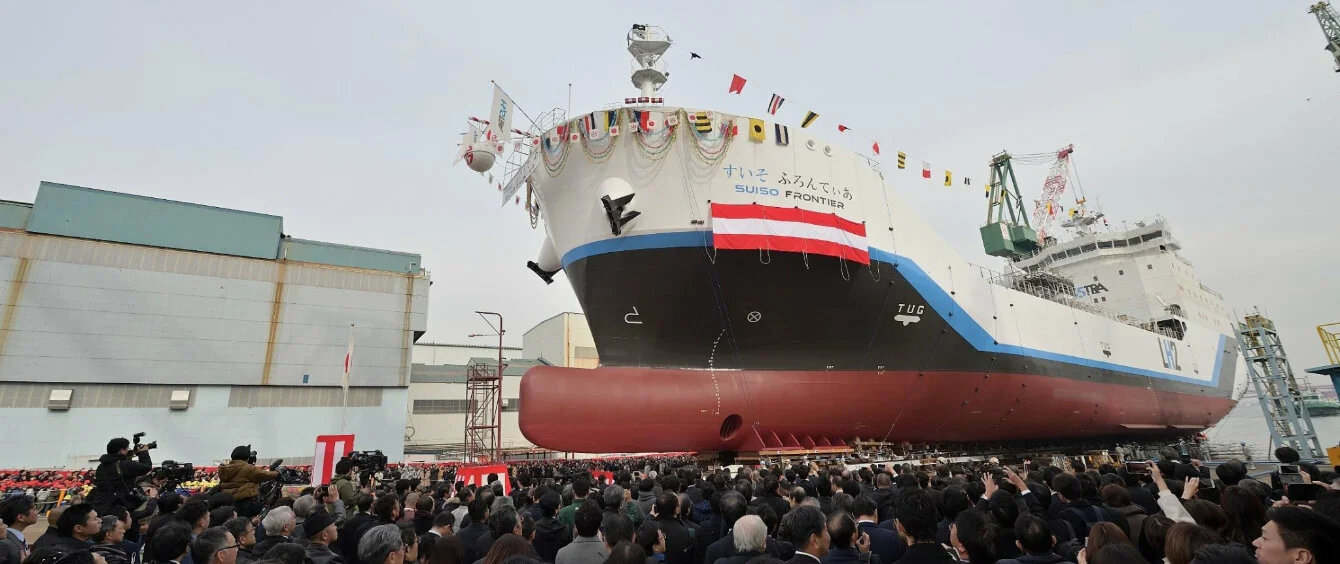With few gas resources of its own Japan is one of the world’s largest importers of liquified natural gas (LNG). The fuel makes up about 22% of Japan’s primary energy supply with the largest portion, just under 40% sourced from Australia. As reported in the en:former, Japan wants to rely heavily on hydrogen for its energy supply and eventually become a hydrogen-based society.
However, the two countries are looking for a more sustainable alternative – international trade in liquified hydrogen.
Japan has already made advances in developing a hydrogen economy, with the long-term aim of repurposing its extensive LNG import infrastructure. The country leads in terms of the number of hydrogen fuel stations for road vehicles, and, in March 2020, completed the world’s then largest-in-class renewable energy hydrogen production plant, a 10-MW project based in Fukushima.
Now, a Japanese-Australian venture to create a full hydrogen supply chain has moved a step further, delivering the first seaborne liquid hydrogen cargo to an international market.
Suiso Frontier
The world’s first liquified hydrogen carrier, the Suiso Frontier, completed its maiden round-trip voyage to Australia at the end of February, in what may be the start of a new era in global energy trade.
The ship, built by Kawasaki Heavy Industries (KHI), left Japan in December last year and arrived at the Port of Hastings in Victoria state, Australia in January. It loaded liquid hydrogen before traversing 5,511 nautical miles back across the Pacific Ocean to the Port of Kobe, arriving at the end of February, each leg of the journey taking about 23 days at 10 knots.
The Suiso Frontier is much like a small LNG carrier. It has gross tonnage of 7,849 tons, is 116 metres in length and 19 metres across the beam. The ship’s containment system has a capacity of 1,250 m3. As one cubic metre of liquified hydrogen weighs 70kg, it can carry 87.5 tons of hydrogen fully laden.
The Suiso Frontier is much like a small LNG carrier. It has gross tonnage of 7,849 tons, is 116 metres in length and 19 metres across the beam. The ship’s containment system has a capacity of 1,250 m3. As one cubic metre of liquified hydrogen weighs 70kg, it can carry 87.5 tons of hydrogen fully laden.
Suiso Frontiers maiden round-trip voyage
Full supply chain
The Suiso Frontier is a critical link in what is a much larger supply chain, one which starts in Australia’s Latrobe Valley at the site of the Loy Yang power complex.
Hydrogen is produced by gasifying brown coal to produce syngas, which comprises mainly carbon monoxide and hydrogen. The syngas is processed with steam to produce additional hydrogen and carbon dioxide and the gases are then separated.
The hydrogen is then transported by high pressure road tankers to a liquefaction plant at Hastings. The liquefaction plant uses the same technology employed in the LNG sector to cool the gas to minus 253°C (substantially colder than LNG’s minus 162°C), which reduces it to one eight-hundredth of its original volume.
The liquid hydrogen is held in storage tanks made by KHI, which also built the tanks used to store hydrogen rocket fuel at the Japan Aerospace Exploration Agency.
Back in Kobe, ready for the Suiso Frontier, is the largest liquified hydrogen tank in Japan and the world’s first liquified hydrogen unloading arm.
The Australian part of the project was coordinated by the Hydrogen Engineering Australia consortium, while the Japanese part was organised under the auspices of the CO2-Free Hydrogen Supply Chain Technology Association.
Scaling up
The Suiso Frontier’s first delivery of liquid hydrogen is just the start. In Victoria, the Australian arm of the operation envisages production in the 2030s amounting to 225,000 tons of liquid hydrogen a year.
As the hydrogen is produced from brown coal this means significant carbon dioxide emissions as a by-product of the gasification and separation processes. At commercial scale, these emissions will be mitigated by a carbon capture and storage facility at the Loy Yang site. The small volume of carbon dioxide produced in the pilot stage was offset by the purchase of carbon certificates.
However, the Japanese portion of the project, focussed on bulk hydrogen transportation, has more widespread application, allowing the import of hydrogen produced from any source. The development of a liquified hydrogen shipping fleet could access abated and renewably-generated hydrogen across Australia and in other parts of the world.
In May last year, Kawasaki obtained an approval in principal from Japanese classification society Nippon Kaiji Kyokai for a cargo containment system with capacity of 40,000 m3, which promises hydrogen carriers of a similar size to today’s LNG carriers.
The containment system uses an independent, self-supporting structure which responds flexibly to thermal contraction and expansion. Its insulation systems limit boil-off gas, which is used to power the ship, helping to reduce carbon emissions in transit. Just as LNG carriers run on LNG, hydrogen carriers should be able to run on hydrogen.
KHI is working on a four-tank carrier with capacity of 160,000 m3, which it expects to deploy in the mid-2020s.
